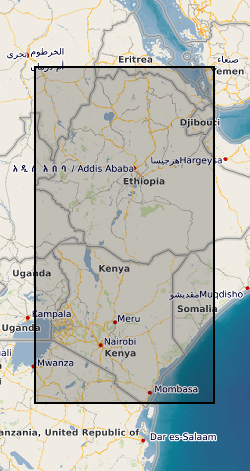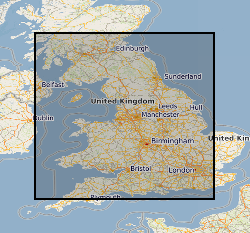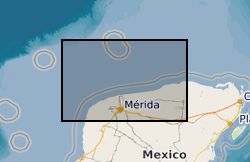Geological data
Type of resources
Available actions
Topics
Keywords
Contact for the resource
Provided by
Years
Formats
Representation types
Update frequencies
Service types
Scale
Resolution
-

This Web service provides layers which are part of the BGS Superficial Deposits Thickness Model (SDTM) series of datasets. It currently includes two layers from the STDM 1 km hex grid dataset, which is available under the Open Government Licence. These two layers are symbolised on the mean and maximum values of the BSTM thickness model within the area of each hexagon. In these two layers, note that the data include a generic value of 1 m thickness for any area where superficial material is present, but is unproven by boreholes (shown on the map by a grey colour).
-

Digitized GIS geological and geochemical datasets taken from maps and reports as part of BGS Overseas Development Research in 1980-90s.
-

This dataset shows the variation of the thickness of superficial (Quaternary age) deposits across Great Britain. The data are presented as a vector map of interlocking hexagon cells (side length 1 km, area c. 2.6 km2) covering the landmass of Great Britain as a regular grid. Each hexagon cell is attributed with statistics about the thickness of the underlying Quaternary units (average thickness and maximum thickness) for that cell. Additional information relating to the coverage of the underpinning data is also provided. The data are derived from the BGS Basic Superficial Thickness Model (BSTM). The data is all derived by spatially summarising the information within the BGS Basic Superficial Thickness Model (BSTM), which is a 50 m cell size raster model of superficial thickness, first published in 2010.
-

This dataset comprises data from Wessex Archaeology surveys which were conducted over various wreck sites between 2003 and 2010. Three of these datasets were acquired in English waters, one in Welsh waters and one in Scottish waters. The geology and geophysics component of the data are archived by British Geological Survey (BGS) in the Marine Environmental data and Information Network (MEDIN) Data Archive Centre (DAC) for Geology and Geophysics. The data include multibeam echosounder, single-beam echosounder, sidescan sonar, sub-bottom profiler, magnetometer, and geological data (vibrocore logs and photos). Data were also provided to other archive centres as appropriate - UKHO (bathymetry), Royal Commission Ancient and Historic Monuments Wales (geophysics), Royal Commission on the Ancient and Historical Monuments of Scotland (geophysics and diving/ROV), Archaeology Data Service (diving/ROV). Although generated for archaeological purposes, these high quality and resolution data are capable of re-use by marine surveyors and scientists from a range of different fields. Data are delivered via the BGS Offshore GeoIndex www.bgs.ac.uk/GeoIndex/offshore.htm and additional data are available on request enquiries@bgs.ac.uk.
-

This Web service provides layers which show data relating to offshore survey activities undertaken by the British Geological Survey (BGS) and its predecessors. The layers are polygon, line and point layers which indicate the spatial areas of survey activities. The survey overview layer shows the location and basic information for coastal and marine surveys. It includes information about the survey, including the types of equipment deployed during the survey. For some surveys, a zip file of additional data can be downloaded using the URL link provided where available. The geophysical surveys layers show survey lines and shot points along those lines, where applicable. Geophysical surveys include shallow seismic reflection (e.g. airgun, boomer, pinger, sparker and water gun) and sonar (e.g. echo sounder, sidescan sonar and transit sonar). There may be several types of equipment deployed on a single survey line. Survey lines are uniquely named with a survey and line identifier (name or number). For example, 1985/6#16 is line 16 of survey 1985/6. The lines layer includes seismic reflection (sub seabed imaging which provides information about structures below the seabed) and sonar (seabed imaging which provides information about the roughness of the seabed or simple bathymetric data). Links to scanned images of geophysical records are provided (where available) for openly available survey lines where terms of use are known. The backscatter layer shows the location and basic information for bathymetric surveys containing backscatter data. A zip file of the backscatter image files for the survey can be downloaded using the URL link provided. Note that there can be more than one polygon per survey and these will link to the same zip file for the entire survey. The majority of the data were collected and processed for the Maritime and Coastguard Agency (MCA) under the Civil Hydrography Programme. To download the related bathymetry data go to the Admiralty Marine Data Portal (https://datahub.admiralty.co.uk/portal/apps/sites/#/marine-data-portal). The oil and gas industry site surveys layer shows the geographic location of oil and gas industry site surveys. The metadata for these surveys were collated via the BGS MEDIN Data Archive Centre (DAC). BGS do not hold the data. For further information contact the custodian of the data. For more information, contact BGS Marine Enquiries (offshoredata@bgs.ac.uk).
-

Data identifying landscape areas (shown as polygons) attributed with geological descriptions and thermal properties of geological materials. The scale of the data is 1:250 000 scale for the Thermal Properties V1 dataset. Onshore coverage is for Great Britain and the Isle of Man. This dataset shows thermal properties relating to bedrock beneath our feet. The information can be used to assess the potential for closed and open loop ground source heat pumps across, or deeper geothermal assessments, across the United Kingdom. The attribution and spatial data underpinning the model are that which is described and shown by Rollin (1987) and Gale (2004, 2005). The information is presented vector-based, irregular polygon coverage at 1:250 000 scale Each polygon is attributed with a range of geological properties including modelled values for Thermal conductivity, thermal diffusivity, specific heat capacity and density. The data are available in vector format (containing the geometry of each feature linked to a database record describing their attributes) as ESRI shapefiles and are available under BGS data licence.
-

Data identifying landscape areas (shown as polygons) attributed with geological names and rock type descriptions. The data is presented at 1:50 000 scale. Onshore coverage is provided for England, Scotland, Wales and the Isle of Man. Approximately 99% coverage is available and BGS is committed to completing the coverage, and ongoing updates as part of its ongoing national survey. Bedrock geology describes the main mass of solid rocks forming the earth's crust. Bedrock is present everywhere, whether exposed at surface in outcrops or concealed beneath superficial deposits or water bodies. The bedrock geology of Great Britain is very diverse and includes three broad classes based on their mode of origin: igneous, metamorphic, and sedimentary. The data includes attribution to identify each rock type (in varying levels of detail) as described in the BGS Rock Classification Scheme (volumes 1-3). The bedrock has formed over long periods of geological time, from the Archean eon some 4000 million years ago, to the relatively young Pliocene, 5.33 million years ago. The age of the rocks is identified in the data through their BGS lexicon name (published for each deposit at the time of the original survey or subsequent digital data creation). For stratified rocks i.e., arranged in sequence, this will usually be of a lithostratigraphic type. Other rock types for example intrusive igneous bodies will be of a lithodemic type. More information on the formal naming of UK rocks is available in the BGS Lexicon of Named Rock Units. Geological names are based on the lithostratigraphic or lithodemic hierarchy. The lithostratigraphic scheme arranges rock bodies into units based on rock-type and geological time of formation. Where rock-types do not fit into the lithostratigraphic scheme, for example intrusive, deformed rocks subjected to heat and pressure resulting in new or changed rock types; then their classification is based on their rock-type or lithological composition. This assesses visible features such as texture, structure, mineralogy. The data are available in vector format (containing the geometry of each feature linked to a database record describing their attributes) as ESRI shapefiles and are available under BGS data licence.
-

Data identifying landscape areas (shown as polygons) attributed with type of mass movement e.g. landslip. The data is presented at 1:50 000 scale. Onshore coverage is provided for England, Scotland, Wales and the Isle of Man. Approximately 99% coverage is available and BGS is committed to completing the coverage, and ongoing updates as part of its ongoing national survey. Mass movement describes areas where deposits have moved down slope under gravity to form landslips. These landslips can affect bedrock, superficial or artificial ground. Mass movement deposits are described in the BGS Rock Classification Scheme Volume 4. However, the data also includes foundered strata, where ground has collapsed due to subsidence (this is not described in the Rock Classification Scheme). Caution should be exercised with this data; historically BGS has not always recorded mass movement events and due to the dynamic nature of occurrence significant changes may have occurred since the data was released. The data are available in vector format (containing the geometry of each feature linked to a database record describing their attributes) as ESRI shapefiles and are available under BGS data licence.
-

Data identifying landscape areas (shown as polygons) attributed with geological names and rock type descriptions. The data is presented at 1:50 000 scale. Onshore coverage is provided for England, Scotland, Wales and the Isle of Man. Approximately 99% coverage is available and BGS is committed to completing the coverage, and ongoing updates as part of its ongoing national survey. Superficial deposits are the youngest geological deposits formed during the most recent period of geological time, the Quaternary, which extends back about 2.58 million years from the present. They lie on top of older deposits or rocks referred to as bedrock. Superficial deposits were laid down by various natural processes such as action by ice, water, wind, and weathering. As such, the deposits are denoted by their BGS lexicon name, which classifies them the basis of their mode of origin (lithogenesis) with names such as, 'glacial deposits', 'river terrace deposits' or 'blown sand'; or the basis of their composition such as 'peat'. Most of these superficial deposits are unconsolidated sediments such as gravel, sand, silt, and clay. The digital data includes attribution to identify each deposit type (in varying levels of detail) as described in the BGS Rock Classification Scheme (volume 4). The data are available in vector format (containing the geometry of each feature linked to a database record describing their attributes) as ESRI shapefiles and are available under BGS data licence.
-

BIRPS (the British Institutions Reflection Profiling Syndicate) acquired almost 650 km of offshore seismic data and 300 km of onshore seismic data over the Chicxulub impact crater. The data were recorded to 18 s two-way time.
 NERC Data Catalogue Service
NERC Data Catalogue Service